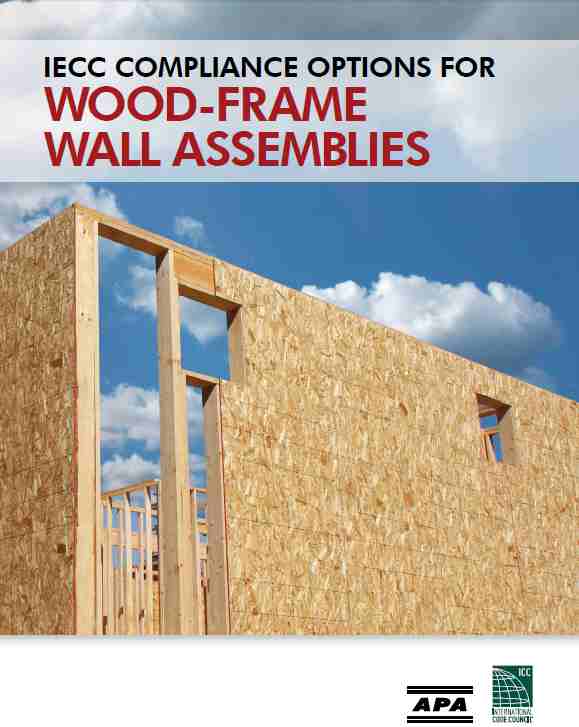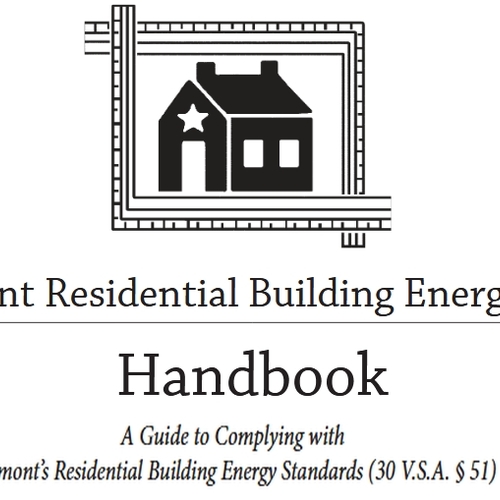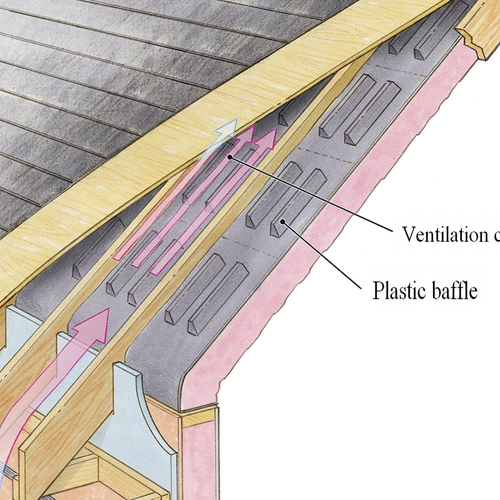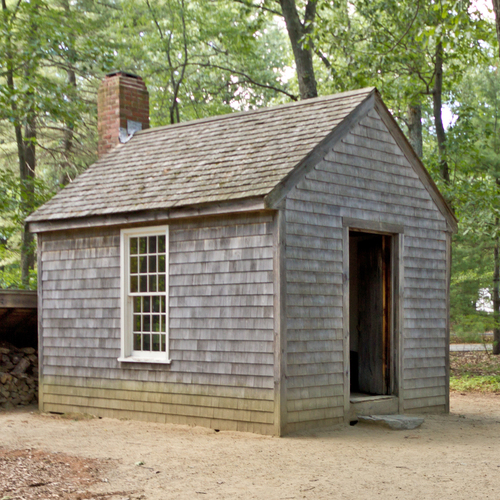
Image Credit: APA
Builders often talk about the R-value of their walls. But if a builder claims to have an R-20 wall, what does that mean?
Building codes commonly include a table listing the minimum prescriptive R-values for walls and ceilings in different climate zones. For example, Table R402.1.1 in the 2012 International Energy Conservation Code (IECC) informs builders that the minimum prescriptive R-value for walls in Climate Zones 3, 4, and 5 is “20 or 13+5.”
This type of table raises many questions. For example, if a builder chooses to comply with the R-20 option, how is R-20 calculated? The code provides some guidance on the issue, but not much. According to a footnote at the bottom of the table, the “first value is cavity insulation, second is continuous insulation or insulated siding, so ‘13+5’ means R-13 cavity insulation plus R-5 continuous insulation or insulated siding.”
Complying with the code usually means installing insulation between the studs
The code language governing the prescriptive R-value requirements has changed in recent years. If you want to know the specific language that is enforced in your jurisdiction, you’ll have to consult your local code book. For example, the prescriptive requirements in the 2009 International Residential Code (IRC) note (in section N1102.1.1), “Computed R-values shall not include an R-value for other building materials or air films.”
A footnote to Table N1102.1 in the 2009 IRC — equivalent in most respects to the prescriptive table (Table R402.1.1) in the 2012 IECC — notes, “R-19 batts compressed in to nominal 2×6 framing cavity such that the R-value is reduced by R-1 or more shall be marked with the compressed batt R-value in addition to the full thickness R-value.” This footnote is confusing. Who should do the marking? Does this instruction mean that the builder has to mark the insulation in every stud bay? How do…
Weekly Newsletter
Get building science and energy efficiency advice, plus special offers, in your inbox.

This article is only available to GBA Prime Members
Sign up for a free trial and get instant access to this article as well as GBA’s complete library of premium articles and construction details.
Start Free TrialAlready a member? Log in















17 Comments
Oh I Wish...
Thanks for your post. I am very glad to know "it's not just me". It seems that EVERY TIME I comb through the IRC/IECC I end up with a terrible hangover.
Given that more than just written words are "admissible" nowadays, I surely wish the code was an interactive "living model". Something where I could go on-line, plug in my project's zip code, and click at different pieces of a beautiful model which showed me what I could (and could not do.)
Too much to ask for, I guess.
Code Books? What are those...
When I teach classes, I always make a point to ask how many people owns a code book, never mind that in most municipalities is a combination of several code books. Anyways...It's usually ZERO, but now and then I'm surprised when one or two SAY they do. That applies to Builders, Architects and Designers... very few Subs take these classes.
Armando.
Point taken - but I think stretched a bit. I've never met or heard of an architect who didn't own a code book. They may not have been familiar with all its requirements but they have one.
Sorry but it's the truth
Malcom, all the comments I make in any blog or website are 100% my experiences, no BS, lies or stretches. I just taught a class in Santa Fe with 20+ Builders and Architects, and not a single one person in that class owned a code book. Many of them read this website and they can tell if I'm "stretching" it. Same in TX, CO, KS, OK and in almost every class I've taught. Just because this is not your experience, you should not call me less than truthful.
Armando,
I didn't mean to imply you are liar. I simply don't understand how this can be the case. You can not function as an architect without constant access to the building code. Even for small practices only working on individual houses I don't see how it can be done. While they may have told you this for some reason, I'd be interested to see if any come forward to this website and support your assertion.
Own vs. access
One thing is owning a copy of the code, another thing is knowing how to quickly access information in it.
We have a full pdf version of the 2009 IRC, but don't actually "own" the 2012. One reason in particular: http://publicecodes.cyberregs.com/icod/irc/2012/
and our local amendments: http://permittingservices.montgomerycountymd.gov/dps/building/BuildingCodes.aspx
Many of my books sit on the shelf, collecting dust. This is due large in-part to the my ability to access current information much more quickly on-line than finding the book, chapter, paragraph, and keyword. By the time a book is actually published, a certain amount of it is conceivably already outdated.
Of course this method is no substitute for simply "knowing' the right answer, but I can't always trust what I "know" is actually to code anymore, due to how quickly it all changes, especially in my particular state (the only one in the Country which automatically adopts the latest code as soon as it comes out).
IECC does have language about slab insulation
There is a free copy of the 2012 IECC available here:
http://publicecodes.cyberregs.com/icod/iecc/2012/
This section explains what is meant by slab insulation "depth". Once you get to this section it's relatively clear:
R402.2.9 Slab-on-grade floors.
Slab-on-grade floors with a floor surface less than 12 inches (305 mm) below grade shall be insulated in accordance with Table R402.1.1. The insulation shall extend downward from the top of the slab on the outside or inside of the foundation wall. Insulation located below grade shall be extended the distance provided in Table R402.1.1 by any combination of vertical insulation, insulation extending under the slab or insulation extending out from the building. Insulation extending away from the building shall be protected by pavement or by a minimum of 10 inches (254 mm) of soil. The top edge of the insulation installed between the exterior wall and the edge of the interior slab shall be permitted to be cut at a 45-degree (0.79 rad) angle away from the exterior wall.
Response to Douglas Horgan
Douglas,
Thanks very much for providing that code reference. It's a section that I somehow missed. I'm grateful for the reference, and I have edited my article for accuracy.
The most curious aspect of section R402.2.9 of the 2012 IECC is that it does not require any insulation for above-grade slabs. The only slabs that are required to be insulated are “Slab-on-grade floors with a floor surface less than 12 inches below grade” -- a rare type of construction.
Most concrete slabs are either above grade (usually between 4 inches and 8 inches above grade), or are more than 12 inches below grade (for example, basement slabs).
iECC is NOT the code every where
NYS Code.... Is.... NYS Code.
We modify IECC code and implement codes years later than published.
And if code is a builders or Arch's problem then they sure must have greater issues.
Response to Martin,
I think you are reading it a bit too narrowly. Isn't the distinction that provision is trying to address that between slabs more than 12" below grade and all other slabs above that height?
Response to Malcolm Taylor
Malcolm,
Yes, I think you've put your finger on it -- it's probably another example of the inability of code writers to write English.
Let's see -- is there a difference between slabs that are "below grade" and slabs that are "above grade"? Why, yes -- I think there is.
But the code writers never mentioned what to do with slabs that are above grade.
Are these two sentences equivalent? You decide.
1. My proposed version: "Slab-on-grade floors that with a floor surface that is above grade or that is less than 12 inches (305 mm) below grade shall be insulated in accordance with Table R402.1.1."
2. The existing language: "Slab-on-grade floors with a floor surface less than 12 inches (305 mm) below grade shall be insulated in accordance with Table R402.1.1."
Martin,
Your wording would help a lot.
Obscure code language can have much larger consequences in rural areas where most of the enforcement is done by inspectors on site when things are already built, rather than plan checking before construction starts. It also undermines client's faith in their designer when you can't guarantee that what you draw will pass inspection.
Response to Malcolm Taylor
Malcolm,
If only the International Code Council would hire a few unemployed English majors, we could clarify the building code and lower the unemployment rate for liberal arts graduates.
.
Martin
Send a few our up here, ours is just as bad.
I think part of the problem is that code writers write for code writers. I changed the way I label drawings and write specifications when I realized that architects write for architects, rather than the builders and subs that have to interpret them. Much of the jargon can be replaced by plain english equivalents, and a lot of it is included just to cover our asses.
90.1 Appendix A
Our work is mostly commercial and we use ASHRAE 90.1 Appendix A to determine whole assembly U-values. Not perfect but it is a pretty organized and understandable way to estimate the whole assembly performance.
Hangover starting
2. The existing language: "Slab-on-grade floors with a floor surface less than 12 inches (305 mm) below grade shall be insulated in accordance with Table R402.1.1."
I confused by your interpretation Martin. The code seems to ask that slabs near or above grade be insulated. Makes sense. That surface is colder (winter) or warmer (summer) than anything below 12". To my mind a basement slab 4 or more feet below grade would need less or no insulation as that ground surface is much more moderate in temperature through the seasons than the ground surfaces closer to grade. This is the principle of geothermal energy is it not?
Response to Tony Ferrera
Tony,
I'm not questioning the logic that calls for less insulation for slabs that are deeply below grade than for slabs that are near grade. That makes sense.
What I am questioning is the confusing language of the code, which discusses the requirements for slabs that are "below grade," but which is silent on what should be done with slabs that are above grade.
Log in or become a member to post a comment.
Sign up Log in